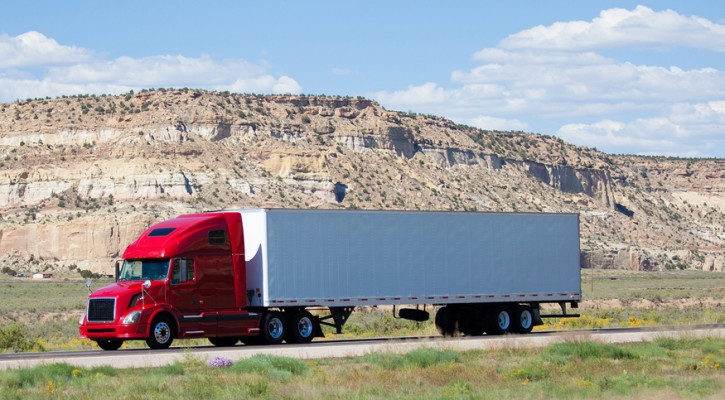
Pros and Cons of Teaming Up
March 22, 2014
Truck driving is a demanding job. However, teaming up with a reliable partner – maybe even a husband or wife – is a great way to lighten the load.
Pros
1. Quicker Deliveries. By staggering sleep schedules, team drivers can cover twice as many miles as a solo driver.
2. More Opportunities. Clients and employers prefer the most efficient drivers. The quicker the goods get delivered, the more money everyone makes.
3. Less Loneliness. There will always be someone beside you. When not sleeping, that person can help with navigation, as well as provide great conversation. And when the delivery is completed, you’ll have someone to hit the town with.
Cons
1. No Stopping. With staggered sleep schedules, ya’ll can keep on trucking all the way across the country. Besides a few pit stops, there won’t be many opportunities to take a break from moving down the road.
2. Back-Seat Drivers. If one person is more adept at handling an 18-wheeler (or thinks they are), then expect a steady flow of criticism.
3. No Alone Time. If you’re teaming up, even if it’s with a spouse, you had better make sure that the two of you will not get sick of each other. Even married couples can’t stand to be together for too long of a time period, and everyone has a tick or a pet peeve that can really drive them mad. Find a driving partner that you’re sure will make a great match, then test the relationship with a long road trip.

The Truth About Trip Planning
March 21, 2014
Take it from a trucker: the best laid plans can fall to pieces. It’s all a gamble, really, but it makes for a great read. See the full story here:
http://www.truckingtruth.com/trucking_blogs/Article-3815/the-best-laid-plans-can-fall-to-pieces

Trucker Health on the Long Haul
March 21, 2014
According to the CDC (Centers for Disease Control and Prevention), the average life expectancy for a truck driver is 16 years less than the national average. With poor food options, long driving hours, erratic sleep patterns and little chance for exercise, it’s really no surprise that truckers are suffering from certain health problems.
However, these health issues are far from impossible to overcome. Though the occupation has its obstacles, a healthy lifestyle is easily within reach when we understand the common conditions and causes of early deaths in the trucking industry.
Sleep Deprivation. The FMCSA (Federal Motor Carrier Safety Administration) recently passed stricter regulations on hours-of-service for truck drivers. While the extent of these regulations is highly controversial, everyone agrees that truckers need to get sufficient sleep to drive safely. Without a good six hours of deep sleep, cognitive abilities suffer and health risks greatly increase. Sleep deprivation has been linked to a variety of chronic diseases such as hypertension, diabetes, depression and obesity. A lack of sleep also contributes a weaker immune system, which in turn increases the risk of cancer, among other diseases and viruses. While the debate on the federal level rages on, truckers and their employers can discuss trip planning and work strategies to ensure a good night’s rest. An investment in a good mattress or tempurpedic mattress topper isn’t a bad idea either.
Sleep Apnia. According to a study done by Virginia Tech Transportation Institute, 25% of drivers are at risk of developing sleep apnia. Sleep apnia is a chronic condition which causes breathing problems while you sleep, resulting in a poorer quality of sleep and excessive daytime drowsiness. Sleep quality is extremely important, and a good, deep sleep is required to get the health benefits drivers need. In fact, drivers with sleep apnia are 4.6 times more likely to cause an accident. This condition often goes unnoticed because the person only experiences the breathing problems while asleep. It is a common problem for people who are overweight, and can increase the risk of high blood pressure, heart attack, stroke, obesity and diabetes, as well as work-related accidents. For more information on diagnosing and treating sleep apnia, visit http://www.nhlbi.nih.gov/health/health-topics/topics/sleepapnea/.
Lack of Exercise. A change in the sedentary lifestyle will drastically improve health across the board. The two previous health issues listed (sleep deprivation and sleep apnia) are both problems that could be related to a general lack of exercise. Besides sleeping problems, lack of exercise also contributes to obesity, heart disease and work-related injuries. Obviously, spending 14 hours on the road eating truck stop food is not the best way to prepare for the labor-intensive work of loading and unloading heavy cargo. There are plenty of exercise routines that are easy to do on the road, and even in the sleeper of the truck. Things like push-ups, crunches and squats don’t require much room at all, and provide both muscle-building and cardiovascular benefits. Just 15 minutes of exercise a day is enough to improve overall health, and also contributes to stimulated brain activity and a better mood. When truckers are home with their families, an active lifestyle of walking, hiking, playing sports or swimming is also a great way to get more exercise.
Poor Diet. Much like exercise, food is one of those things that affects every other aspect of your health. However, fast food and truck stops usually don’t offer any beneficial edibles – and in fact, most of the food you’ll find at these places is downright poisonous. All the sodium and corn-syrup laden choices offered are a big reason the majority of America is suffering from obesity, diabetes and heart disease. If your truck has a small refrigerator, then stop at the grocery store and stock up on real food and make yourself some real home-cooked meals. It doesn’t necessarily have to be diet food, either. A home-cooked hamburger is still much healthier and leaner than the corn syrup-injected sodium-lathed stuff you’d find at a McDonald’s. Go healthier by choosing leaner ground beef, stuffing it full of garlic, peppers and onions, topping it with a mountain of lettuce and then serving it on a whole wheat bun. For the fridge-less, there are still plenty of options at the grocery store, including beans and rice, peanut butter and jelly, and fruits and vegetables. Don’t forget a nice, big bag of mixed nuts for snacking.
So there you have it. It’s simple, really: Eat good. Exercise daily. Sleep well. Oh, and drive safe!
FMCSA Cracks Down on Bus and Trucking Operations
March 20, 2014
The Federal Motor Carrier Safety Administration (FMCSA) announced the immediate shut-down of four motor carriers today: two passenger carriers and two trucking operations. The violations ranged from failing to test for drugs and alcohol to improper maintenance and repairs, to driving without a commercial drivers license.
So far in 2014, the FMCSA has shut down five passenger carriers, two property carriers and four commercial drivers because of imminent hazards to the public. Additionally, the FMCSA is working on the behalf of consumers to provide data on passenger carrier safety records. The FMCSA’s “Look Before You Book” app is a free way to view these safety records, and can be found at http://www.fmcsa.dot.gov/saferbus.

Truckers Called on to Save the Salmon
March 20, 2014
Truckers are often called upon in times of emergency, but this time the emergency is a little fishy. Read the full report here:
http://www.thetruckersreport.com/truckers-may-haul-millions-of-live-salmon-to-the-ocean-this-year/
Hypermiling 101: Ten Tips for Better Gas Mileage
March 20, 2014
You may have seen hypermilers before. They’re those pesky people that drive slow, coast up to stop lights at turtle-speed, and are constantly cutting their engines in fast food drive-through’s. However, if we only knew how much gas they were saving then everyone would be driving this way. In fact, some hypermilers are routinely getting 40 – 50 mpg in old cars that have mpg ratings in the 20’s. That’s nearly twice the gas mileage! So, let’s take just 10 tips from these ingenious hypermilers and see what we can get:
1. Easy on the accelerator. Though it may seem obvious, most drivers overlook this simple gas-saving trick. Avoid quick acceleration, drive under 60 mph, coast down hills, slow down and avoid the brakes around turns, and always release the gas early when approaching stop signs and stop lights for a slow-rolling, gas-saving stop.
2. Lighten the Load. Excess junk in the trunk can affect gas mileage, especially when the cumulative weight exceeds 100 lbs. Unused roof racks and bike racks can take their toll as well, adding both weight and wind resistance.
3. Tune it up. A simple tune up is great for gas mileage. In fact, it could raise your fuel economy by as much as 10%. For oil changes, using a lighter viscosity or multigrade oil will also improve efficiency. And, installing an engine-block heater will give you more efficient starts.
4. Pump up the tires. The more pressure in your tires, the better the gas mileage. So, always fill your tires up to the maximum pressure listed on the sidewall.
5. Avoid the Dreaded Idle. Long lines at gas stations and fast food stops force you to idle, at which point you are getting 0 mpg. If you’re stopping for more than 30 seconds, then you might as well just turn the engine off. Better yet, plan your trips accordingly and avoid those pitfalls altogether.
6. Go with the flow. A little lesson in physics here: all variables being equal, it is more efficient to drive at a constant speed within the flow of traffic than to drive at a constant speed in isolation. Dubbed the “corridor effect”, this aerodynamic oddity occurs when the flow of traffic generates a localized wind current.
7. Mind the wind. Strong winds can be a big factor in fuel efficiency. If possible, plan your trips to avoid strong headwinds and take advantage of strong tail winds. If crosswinds are an issue, look for a route with wind barriers such as trees, cliffs and infrastructure.
8. Drive hot. Driving in warmer weather improves gas mileage for multiple reasons. For one, a cold engine is less efficient. Also, cold tires and a cold drivetrain experience more rolling and mechanical resistance.
9. Fuel up early. Gasoline has physical properties that allow it to contract and expand depending on temperature. Pumping early in the morning could get you more gasoline per gallon, because overnight the gas becomes colder and more dense.
10. Get the Tech. Today’s technology gives us instant feedback on all our hypermiling efforts. There are plenty of companies that sell fuel-consumption gauges, as well as smartphone apps that can retrieve data from the black box on your car.

91% Turnover Rate
March 18, 2014
High turnover rates continue in the trucking industry. At large truckload carriers, the turnover rate fell six percentage points to 91% at the end of 2013. Meanwhile, small truckload fleets had a 79% turnover rate in the final quarter, down from the 82% mark that has held since the beginning of 2012. With economic growth and 30,000 unfilled truck driving jobs, employers will face increasing pressure to improve working conditions. Read the full story here.
http://www.overdriveonline.com/turnover-at-large-truckload-carriers-falls-at-year-end/
Trucker Shows: The Good, The Bad and the Ridiculous
March 18, 2014
Since Ice Road Truckers premiered on the History Channel in 2007, reality TV has developed a keen taste for truckers and their way of life.
SPEED premiered their show American Trucker in 2011, which helped viewers across the country better understand the hassles and hardships many truckers face, as well as the iconic equipment and travels they get to experience. Then there was Shipping Wars on A&E in 2012, which was just a little too fake and dramatic for most tastes. And of course, the list goes on… World’s Toughest Trucker, King of the Road, and Big Rig Bounty Hunters all provided mild amusement with a hint of staged reality.
However, the end is not yet in sight. This funny post over at the Highway Hags blog mentions their interactions with reality TV scouts, and a casting call for “Trucking Couples” has recently ended over at realitywanted.com. The future of trucking reality TV may get a little more interesting, though we all doubt it will get more “real”.
Trucking in the Age of Big Data
March 17, 2014
Things have changed quite a bit since the early days of trucking – the nostalgic Wild West days when drivers could hit the road for months at a time with nothing but a CB radio and a map. Truckers drove old rigs with bad brakes, manual motors and no air conditioning. Rest stops, showers, qualified mechanics, and sleep were all hard to come by, but many look back on those rough-riding times as the glory days.
Today, Truckers drive brand new big rigs with all the comforts and curses of modern technology. Computers keep track of logging hours and driving habits, as well as facilitate communication, navigation and accident prevention. The result is a safer road for everyone to travel. However, the new push for safety is also having unintended consequences.
For example, automated logging and federal regulations have proven to be especially tricky for long haul drivers travelling through congested cities, roadblocks, and severe weather. Any slight delay could mean a hefty ticket for a trucker, and the simple act of finding a place to park often sends drivers 15-30 minutes over their allowed time.
Another issue is a drastic driver shortage due to high turnover. Many old school truckers aren’t too happy about the new wave of safety regulations and amped-up supervision. Meanwhile, youngbloods must submit to drug testing, and have to be ready for real-time analysis of their driving habits, vehicle maintenance, and logging hours. Fleet managers and risk assessment companies are constantly analyzing, planning and directing operations, which means that there is no longer a feeling of “freedom on the open road”.
But it’s not all bad. GPS and geo-fencing technology can help identify problem areas before the driver gets trapped in one. Automatic logs help prevent company owners from forcing long driving hours on their employees. And, the young recruits that get on the safety and supervision bandwagon are sure to be some of the most professional and qualified drivers on the road.
It’s certainly not a bad time to be a trucker, it’s just a bad time to be a “risky” trucker.

Law and Order: CDL Unit
March 17, 2014
The trucking industry has seen a lot of crime lately. First, a company owner was convicted of forcing his employees to work over hours and falsify their logbooks. He ended up with a 2-year prison sentence. Then, another dumb company owner was caught in a conspiracy that involved the stealing of five trucks and 17 trailers, which he allegedly purchased for use in hauling his own legitimate loads. He faces 45 years in jail. And, of course, there’s the run-of-the-mill cargo theft that is always prevalent.
However, what’s really gaining traction in the world of trucking crime is the deceptive pickup. Truckers show up for the delivery, sometimes in a very convincing uniform, and then drive off with the goods without much trouble at all. This is happening with shippers that companies have come to trust, too. After a few successful shipments, paperwork is overlooked and the thieves are allowed to drive off without any questions asked.
Temp drivers can become unexpected pawns in this game, as well. A driver could get a call from Company X, told to pick up Y, drop it off at Z, and told that the paperwork is in the back of the trailer. So, be cautious when working for a new fleet, and don’t be too offended if the next company you deliver for gives you a suspicious look.

